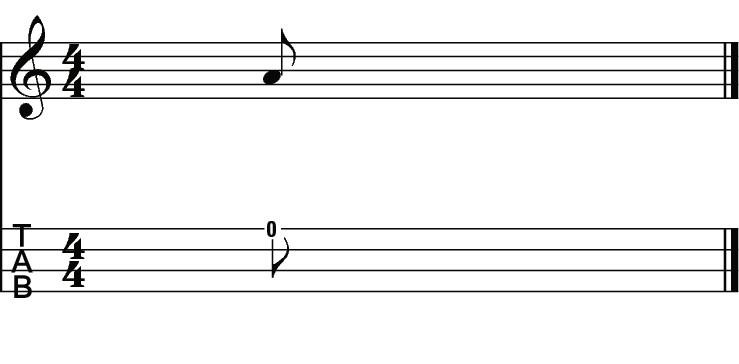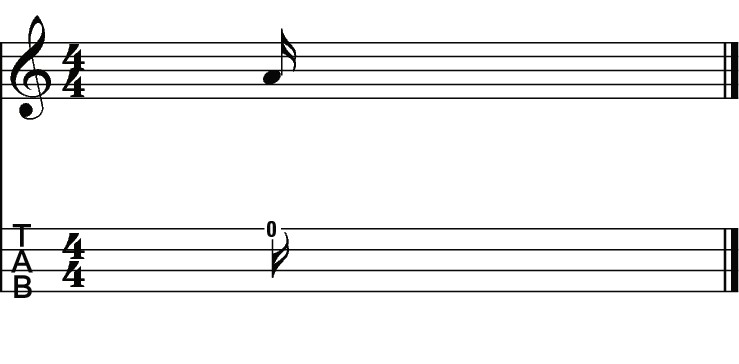Ukulele For Dummies (32 page)
Read Ukulele For Dummies Online
Authors: Alistair Wood

 Flag:
Flag:
A horizontal line that comes out of the opposite end of the stem from the note head. Notes with flags can be connected to each other. When this happens it is known as a
beam
. The fewer of these lines a note has, the longer it lasts.

Comparing US and UK terms
In this book, I use the US terms to indicate note length, putting the UK term in parentheses afterwards. As I explain in the Introduction, I believe that each US term is clearer, more logical and easier to understand than the UK name (and in the case of
quarter note
rather than
crotchet
doesn't sound suspiciously like a physical complaint!). Here are the names of the terms in US English along with the UK English equivalents:
US term | UK term |
Whole note | Semibreve (pronounced âsemi-breeve') |
Half note | Minim |
Quarter note | Crotchet (pronounced âcrotch-it') |
Eighth note | Quaver |
Sixteenth note | Semiquaver |
In this book I use both standard notation and tab (in a simplified form) to indicate rhythm.
Splitting into quarter notes
 When you listen to a piece of music, you feel the pulse of the music. Clap along with any song and you're clapping out its beat. Each of these beats is known as a
When you listen to a piece of music, you feel the pulse of the music. Clap along with any song and you're clapping out its beat. Each of these beats is known as a
quarter note
(crotchet) and is written as in Figure 7-10. Listen to Track 22, Part 1, for an example.
Figure 7-10:
Quarter notes (crotchets) in standard notation (top) and tab (bottom).

Quarter notes (crotchets) have a filled-in note head and stem.
On the tracks in this section, you hear an introduction of four beats; these are four quarter notes (crotchets) and give you the
tempo
(speed) of the example.
Holding on for half and whole notes
Half notes
(minims) last twice as long as quarter notes (crotchets) and are shown as a stem with a hollow note head (see the first two bars of Figure 7-11). When you're counting these, only play every other number. In this example, you play on the one and the three beats (
one
, two,
three
, four,
one
, two,
three
, four).
 Whole notes
Whole notes
(so called because they take up the whole bar, something that the UK equivalent (semibreve) doesn't so clearly convey) last twice as long as half notes (minims). They're indicated by a hollow note head without a stem at all (see the right part of Figure 7-11). Listen to Track 22, Part 2, for an example.
Figure 7-11:
Half notes (minims) and whole notes (semibreves) in standard notation (top) and tab (bottom).

Dividing further: Eighth and sixteenth notes
As well as getting longer, the notes can be shorter than quarter notes (crotchets). The first bar of Figure 7-12 shows quarter notes. The next bar then shows a set of
eighth notes
(quavers), which last half as long as quarter notes (crotchets) That means that two eighth notes take up the same time as a quarter note. They look like two quarter notes connected by a horizontal line (the
beam
).
Eighth notes (quavers) are usually counted âone and two and three and four and'.
 The third bar in Figure 7-12 shows
The third bar in Figure 7-12 shows
sixteenth notes
(semiquavers), which are half as long again. That means four sixteenth notes take up the time of one quarter note. They are written with a double line at the top. They can be counted âone e and a two e and a three e and a four e and a' (so it sounds like âone-ee and uh two-ee', and so on). Listen to Track 22, Part 3, for an example.
Figure 7-12:
Quarter notes (crotchets), eighth notes (quavers) and sixteenth notes (semiquavers) in notation (top) and tab (bottom).

Eighth notes (quavers) don't always come in pairs; you can also see them singly (as Figure 7-13 shows) so you have a flag (the wavy line) rather than a beam (a straight line connected to another eighth note) at the top.
Figure 7-13:
Single eighth note (quaver) in notation (top) and tab (bottom).

Similarly, single sixteenth notes (semiquavers) appear as in Figure 7-14.
Figure 7-14:
Single sixteenth note (semiquaver) in notation (top) and tab (bottom).
